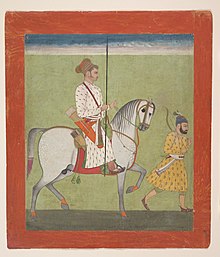Jhujhar Singh
 From Wikipedia - Reading time: 4 min
From Wikipedia - Reading time: 4 min
| Raja Jhujhar Singh Ju Deo | |
|---|---|
| Raja of Orchha | |
 Jhujhar Singh on Horseback, c. 1720–30 | |
| Reign | 1627–1635 |
| Coronation | 1627 |
| Predecessor | Raja Vir Singh Deo |
| House | Bundela Rajput |
| Religion | Hinduism |
Raja Jhujhar Singh Ju Deo was the Bundela ruler of Orchha Kingdom in the 17th century reining from 1627 to 1635 in the cultural Bundelkhand region of modern Madhya Pradesh.
Raja Jhujhar Singh Ju Deo was the first-born son of Raja Vir Singh Deo and the senior of his three queens.[1] In 1626,[2] he succeeded his father as ruler and determined not to remain a vassal of the imperial Mughal Empire as his father had been. His attempt to assert independence from Mughal Emperor, Shah Jahan, led to his downfall. The Mughal army, which was led by the teenager Prince Aurangzeb, conquered his kingdom in the year 1635 and forced him to retreat to Chauragarh.
Death
[edit]Jujhar Singh had written a letter to Kok Shah, the Gond king of Deogarh, to let him pass through his territory unharmed and was waiting for an answer at Chauragarh. He heard rumors that the king of Deogarh was dead and hence he travelled through his territory toward Golconda. However, he and his son were killed by Gonds in the Kingdom of Chanda. Due to Jujhar Singh's attempts at independence, Shah Jahan wrote a farman ordering Khan-i Dauran, Khan-i-Jahan Barha and Firoz Jung to kill Jujhar Singh. Khan-i-Jahan Barha played a crucial role in the suppression of his rebellion.[3] Their heads were cut by Khan-i-Dauran and sent to Firoz Jung to be presented to the Mughal emperor Shah Jahan.[4][5] The Mughal army recovered treasures worth one crore which Jujhar Singh had hidden in various wells in Deogarh territory.[6]
References
[edit]- ^ Jain (2002), p. 84
- ^ Michael (2009), p. 728
- ^ Abha Singh (1990). Jujhar Singh's Rebellion : A Reappraisal. p. 26.
- ^ Welch, Stuart Cary (1987). The Emperors' Album: Images of Mughal India. Metropolitan Museum of Art. ISBN 978-0-87099-499-9.
- ^ al-Dīn (Akbarābādī.), Muḣammad Muʻīn (1905). The History of the Taj and the Buildings in Its Vicinity. Moon Press.
- ^ Sane, Hemant. DEOGARH-NAGPUR GOND DYNASTY.docx.
Bibliography
[edit]- Jain, Ravindra K. (2002), Between History and Legend: Status and Power in Bundelkhand, Orient Blackswan, ISBN 978-8-12502-194-0
- Mehta, Jaswant Lal (2005), Advanced Study in the History of Modern India 1707-1813, Sterling Publishers, ISBN 978-1-93270-554-6
- Michael, Thomas (2009), Cuhaj, George S. (ed.), Standard Catalog of World Coins, 1801-1900 (6th ed.), Krause Publications, ISBN 978-1-44022-801-8[permanent dead link]
 KSF
KSF